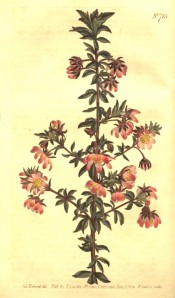Bauera rubioides Andr.
Frost tender, mat-forming to low, spreading, bushy, evergreen shrub with 3-palmate, deep green leaves and solitary, bowl-shaped, pink or white flowers, on long stalks from the upper leaf axils, from spring to summer. To 3m. [RHSE, Hilliers’, Hortus, FNSW].
Horticultural & Botanical History
‘Native of New South Wales, where it was originally found by Sir Joseph Banks. […] It is a handsome shrub, growing to the height of five or six feet, with many branches, and flowering during the greater part of the summer and autumn.’ [LBC no.1313/1829]. ‘A handsome flowering shrub, without scent. Taste of the leaves bitterish, subastringent, not unlike Chinese Tea. […] Received the above name in honour of the two Bauers, natives of Germany, both very eminent botanical draughtsmen in the employ of this country; the elder brother at the Royal Garden at Kew, the younger now on a voyage of discovery in the South-Sea.’ [BM t.715/1804]. Bauera rubioides was introduced to Britain in 1793 by the Marchioness of Rockingham. [ABR pl.198/1801].
History at Camden Park
Listed only in the 1857 catalogue [T.130/1857]. Probably collected locally by Macarthur as it is common in the Sydney region and the Blue Mountains [FNSW].
Notes
Published Feb 26, 2009 - 04:50 PM | Last updated Jul 14, 2010 - 04:50 PM
| Family | Baueraceae |
|---|---|
| Category | |
| Region of origin | Eastern Australia |
| Synonyms |
|
| Common Name | Dog rose, River rose |
| Name in the Camden Park Record | Bauera rubioides |
| Confidence level | high |


